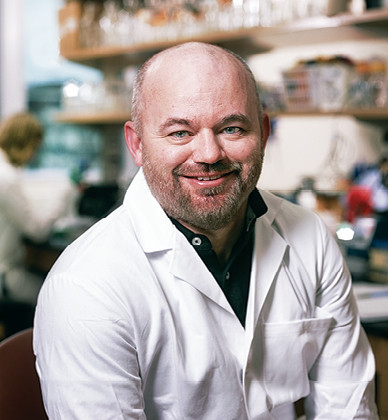Marvin Whiteley, Ph.D.
Molecular Biosciences
Georgia Institute of Technology
Recruited: 2017
Marvin Whiteley is making major discoveries involving bacterial infections, and how communities and populations of bacteria interact. His work points the way to new treatment paradigms that target the mechanisms of bacteria interactions instead of the bacteria themselves. With antibiotic resistance on the rise worldwide, Whiteley’s work is timely and crucial.
One of Whiteley’s early findings pinpointed a stark contrast between how bacteria proliferate in a real-life wound environment versus in a laboratory test tube. He found that while bacteria in a test tube tend to be widely and uniformly distributed, those same bacteria behave very differently in an actual infection site, clustering tightly together in isolated groups.
Whiteley worked with a colleague in the chemistry department at the University of Texas-Austin to create a picoliter-sized container that would more closely model real-life conditions of infections. Whiteley terms this device a “bacterial lobster trap.” His work on this front has encouraged other biologists to begin exploring the concept of “microbial biogeography,” or how bacteria spatially organize themselves.
In a series of significant studies, Whiteley and his colleagues have made fascinating discoveries about the mechanisms of bacterial infection in cystic fibrosis patients. Cystic fibrosis is a hereditary disease that causes the lungs to develop large amounts of sticky mucus, making them an ideal environment for bacteria to thrive. Someone with cystic fibrosis will often acquire a bacterial infection called Pseudomonas aeruginosa when very young; that strain of bacteria will remain in the person’s lungs, causing ongoing health complications.
Whiteley and his team conducted an eight-year study tracking P. aeruginosa infections in three CF patients. The researchers knew that P. aeruginosa bacteria evolve and mutate after colonizing the lungs, and they wanted to track these mutations. They used an innovative method: Instead of sequencing the genomes of the bacteria over time, as other researchers have done, Whiteley and his colleagues analyzed the bacterial RNA to identify which genes in the bacteria were actually being expressed.
Surprisingly, they found a lot of similarities between how the bacteria evolved in each person’s lungs. This separate but parallel evolution could reveal new methods and approaches for treating the infections.
Along with their work in cystic fibrosis, Whiteley and his team also conduct bacterial research in burn wounds, chronic wounds (like bedsores or diabetic foot ulcers) and oral infections.
Whiteley’s lab is also exploring Staphylococcus aureus, another common infection that can be fatal for people with weakened immune systems. Some strains of staph have already acquired resistance to antibiotics. In a 2017 paper, Whiteley’s team identified nearly 200 genes that are essential to the growth of S. aureus bacteria when other types of bacteria are present. Any of these genes could be a potential target for a new type of drug treatment for staph infections.
Research
- High-throughput RNA sequencing to study interactions and synergy of polymicrobial infections
- Electrochemical microscopy analyzing the chemical signals bacteria use to communicate
- Customized microstructures to study small bacterial populations
- Microbial adaptation and mutation of chronic infections
- How environment, nutrients and stresses affect bacterial behavior and growth
Straight from the Scholar
“We’ve discovered a lot of ways that microbes interact and developed tools to study these infections. Now it’s time to make translational impacts, and that’s why we moved — those translational outcomes can be better accomplished in Atlanta. Georgia Tech has strengths in evolution and bioengineering, while Emory and the medical community offer an ability to work with clinicians and patients. Through my first interactions with Emory’s Cystic Fibrosis Center and the physicians there, I can already see the opportunities are even greater than I imagined.”

